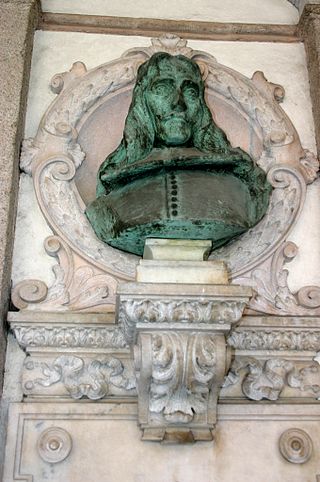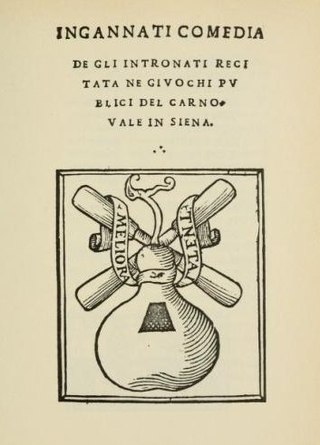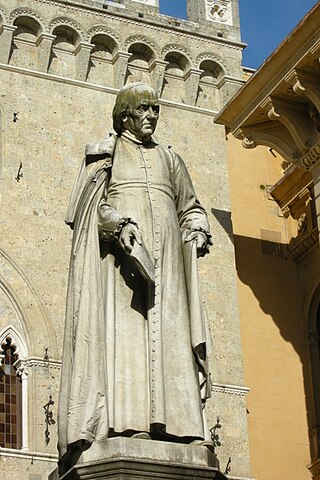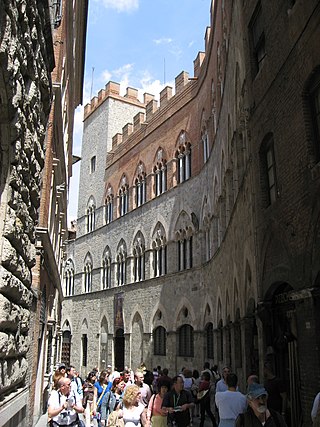Related Research Articles
The Accademia degli Arcadi or Accademia dell'Arcadia, "Academy of Arcadia" or "Academy of the Arcadians", was an Italian literary academy founded in Rome in 1690. The full Italian official name was Pontificia Accademia degli Arcadi.

Alessandro Piccolomini was an Italian humanist, astronomer and philosopher from Siena, who promoted the popularization in the vernacular of Latin and Greek scientific and philosophical treatises. His early works include Il Dialogo della bella creanza delle donne, o Raffaella (1539) and the comedies Amor costante, and Alessandro, which were sponsored and produced by the Sienese Accademia degli Intronati, of which he was a member and an official. Much of his literary production consisted of translations from the Classics, of which Book XIII of Ovid's Metamorphoses and book VI of the Aeneid are early examples. In 1540, while a student at the University of Padua, he helped found the Infiammati Academy, in which he gave lectures in philosophy. His poetry, in which he followed the Petrarchan tradition, appeared first in various contemporary collections, and in 1549 he published as a single volume one hundred sonnets titled Cento sonetti. Later in life, he established in his sister-in-law's Villa of Poggiarello of Stigliano, near Siena, where he attended the revision of his previous essays, and where he wrote all his late works, as the translation of Aristotle's Poetics on which he wrote a learned commentary issued in 1575. His interest in Aristotle included the publication of a paraphrase of Aristotle's Rhetoric with commentary. In his Trattato della grandezza della terra e dell'acqua (1558), he opposed the Aristotelean and Ptolemaic opinion that water was more extensive than land.

Giovanni di Paolo di Grazia was an Italian painter, working primarily in Siena, becoming a prolific painter and illustrator of manuscripts, including Dante's texts. He was one of the most important painters of the 15th century Sienese School. His early works show the influence of earlier Sienese masters, but his later style was more individual, characterized by cold, harsh colours and elongated forms. His style also took on the influence of International Gothic artists such as Gentile da Fabriano. Many of his works have an unusual dreamlike atmosphere, such as the surrealistic Miracle of St. Nicholas of Tolentino painted about 1455 and now housed in the Philadelphia Museum of Art, while his last works, particularly Last Judgment, Heaven, and Hell from about 1465 and Assumption painted in 1475, both at Pinacoteca Nazionale (Siena), are grotesque treatments of their lofty subjects. Giovanni's reputation declined after his death but was revived in the 20th century.
(This article is about the Music of Tuscany outside of the city and province of Florence. For that, see Music of Florence.)

The Accademia di Belle Arti di Bologna is a public tertiary academy of fine art in Bologna, in Emilia-Romagna in northern Italy. It has a campus in Cesena.

The Accademia di Belle Arti di Venezia is a public tertiary academy of art in Venice, Italy.

Giampietro Zanotti (1674–1765) was an Italian painter and art historian of the late-Baroque or Rococo period.
Giacinto Andrea Cicognini (1606–1651) was an Italian playwright and librettist, the son of poet and playwright Jacopo Cicognini.

The Biblioteca Comunale degli Intronati is the public library located at Via della Sapienza #3 of the comune of Siena, in Tuscany, Italy.

Carlo Maria Maggi was an Italian scholar, writer and poet. Despite being an Accademia della Crusca affiliate, he gained his fame as an author of "dialectal" works in Milanese language, for which he is considered the father of Milanese literature. Maggi's work was a major inspiration source for later Milanese scholars such as Carlo Porta and Giuseppe Parini.

The Deceived Ones, or The Deceived, is a 1531 comedy of intrigue written collectively by the Accademia degli Intronati. It was the Academy's first publicly hosted event, performed on the last day of carnival 1532.
The following is a timeline of the history of the city of Siena, Tuscany, Italy.
Accademia often refers to:

Girolamo Gigli was an Italian writer and playwright.
Laudomia Forteguerri was an accomplished Italian poet and a member of one of the most powerful families in the sixteenth-century Republic of Siena. She is considered by some historians to be Italy's earliest lesbian writer, and she was famous for her beauty, wit, and intelligence. In January 1553, Forteguerri led a group of women in helping with the construction of a defensive bastion to protect her city against an anticipated attack from Imperial Spanish forces. The attack and siege that followed in 1554–55 ultimately lead to the fall of the independent Republic. Forteguerri became a legendary figure in Sienese history and her legacy has lived on long after her death.

Sallustio Bandini was an Italian archdeacon, economist, and politician.
Maria Luisa Cicci was an Italian woman of letters and 18th century poet, a member of a member of the literary-scholarly societies (academies) of Arcadians of Pisa and Intronati of Siena; she was a prominent sponsor of literary salons in Pisa.

Count Guido Chigi Saracini, full name Guido Chigi degli Useppi Saracini Lucherini, was an Italian patrician, a musical patron and composer, and a public administrator. Having inherited the Palazzo Chigi-Saracini in the centre of the city of Siena, Tuscany, he applied his musical instincts to his new opportunities, restored the Palazzo in 1923, and established a concert society and later (1932) a musical academy there. The Accademia Chigiana, which flourishes today, grew under his supervision into a famous institution for higher instruction, research and performance in chamber music, playing an important role in the revival of Italian baroque instrumental music, and in the advocacy and performance of contemporary Italian classical music.
Pirro Maria Gabrielli was an Italian physician, residing in his native Siena.
References
- ↑ Elena Brizio, Il Dialogo de’ giuochi by Girolamo Bargagli and the Women of Siena: Culture, Independence, and Politics Women and Community in Early Modern Europe, Issue 15.1, 2018